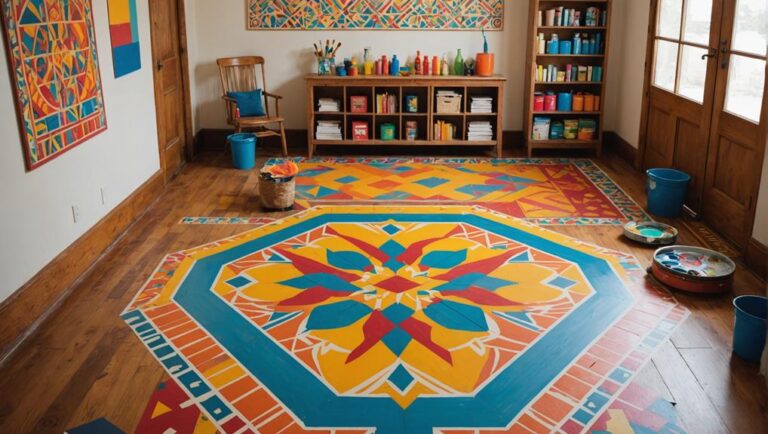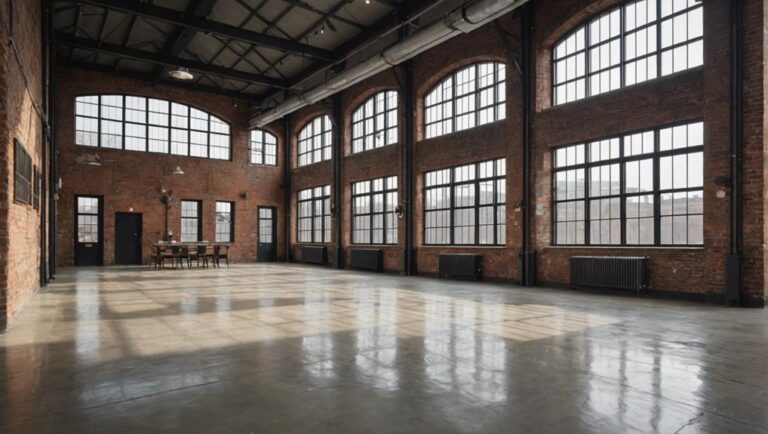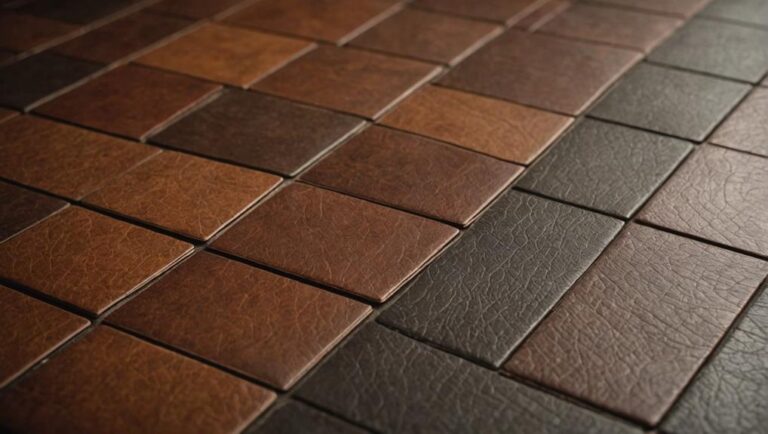To create statement flooring in small spaces, start by accurately measuring your area and evaluating the light. Choose bold patterns, like geometric designs paired with contrasting colors, to draw the eye and create instant impact. Think carefully about color—warm tones evoke coziness while cool colors promote calm. Layer different materials for texture and comfort, mixing hard surfaces with soft rugs or carpets. Consider safety by ensuring materials are slip-resistant and using non-slip backing for rugs. This thoughtful combination will elevate your space, creating a stunning focal point. You might discover even more tips to maximize your design potential.
Assess Your Space
When it comes to creating a statement floor in small spaces, the first step is to evaluate your space. Start by measuring dimensions to get a clear understanding of the area you're working with. Use a tape measure to note length and width, and sketch a simple floor plan. This'll help you visualize how flooring choices will fit within the confines of your space. Remember, accurate measurements are vital to avoid costly miscalculations later on.
Next, take a moment to examine lighting. Natural light can dramatically affect how flooring materials appear, so consider the time of day when evaluating your space. If you've got lots of sunlight pouring in, lighter shades might enhance the brightness, making the area feel more open. Conversely, if your space is dimly lit, darker or vibrant colors could add depth and personality.
Don't forget about safety, too. Check for potential hazards such as uneven flooring or slipping risks, particularly if you have kids or elderly family members. Choosing materials that are both stylish and safe is essential.
Once you've measured and examined, you'll have a solid foundation to build upon when selecting your statement flooring. This thoughtful approach not only guarantees you make the most of your small space but also creates an inviting and functional environment where everyone can feel secure. Your next step will be to explore bold patterns, but first, get this groundwork right.
Choose Bold Patterns
With a clear understanding of your space in hand, it's time to explore bold patterns that can transform your flooring into a striking focal point. Choosing the right design can not only elevate your room's aesthetics but also enhance its perceived size. When selecting bold patterns, consider these three key aspects:
- Geometric Designs: Opt for geometric patterns that create visual interest. Think chevrons, triangles, or intricate hexagons that can draw the eye and make the space feel larger. The symmetry of these designs adds a modern touch while keeping the atmosphere fresh.
- Contrasting Colors: Bold patterns work best when paired with contrasting colors. A classic black-and-white tile can make a dramatic statement, while vibrant blues and yellows can energize the room. Be mindful of your overall color scheme, confirming that the colors enhance rather than overwhelm your small space.
- Scale of Patterns: The size of the patterns plays a significant role in how they affect your space. Larger patterns can create a sense of depth, while smaller designs may feel more intimate. Striking the right balance guarantees that the bold patterns feel harmonious rather than chaotic.
When you choose bold patterns, remember that safety is paramount. Verify that any flooring materials are slip-resistant and suitable for your environment. With these tips, you can confidently create statement flooring that reflects your style and keeps your space safe and inviting.
Incorporate Color Strategically
Incorporating color strategically can breathe life into small spaces, making them feel more vibrant and inviting. By understanding color psychology, you can choose hues that evoke the desired emotions and set the mood for your room. For instance, warm tones like reds and oranges can create a cozy, intimate atmosphere, while cool colors such as blues and greens promote calmness and serenity.
To make the most of your small space, consider using color in accent pieces that draw the eye without overwhelming the area. Here's a simple guide to help you choose your color strategy:
| Color | Emotion Evoked | Suggested Accent Pieces |
|---|---|---|
| Red | Passion, Energy | Throw pillows, rugs |
| Blue | Calm, Tranquility | Artwork, vases |
| Yellow | Happiness, Cheerfulness | Lamps, decorative trays |
| Green | Growth, Freshness | Plants, wall decor |
| Purple | Luxury, Creativity | Cushions, blankets |
When you select your accent pieces, think about how they'll interact with your flooring. A bold rug can tie a room together, while colorful curtains can frame windows and add depth. Remember, the key is balance. Avoid overcrowding your space with too many colors or patterns; instead, opt for a cohesive palette that enhances your overall design. With thoughtful color choices, your small space can feel more expansive and expressive, providing a welcoming haven.
Utilize Texture and Material
While it might seem tempting to stick to a single material in small spaces, embracing a variety of textures can add depth and interest to your flooring design. Textural contrast not only enhances the visual appeal but also creates a safe and comfortable environment. Here are three effective ways to incorporate material combinations into your flooring:
- Mix Hard and Soft: Pair hard surfaces like tile or hardwood with softer materials such as area rugs or carpets. This combination can cushion footsteps, reducing the risk of slips, while also providing a cozy, inviting atmosphere.
- Vary Finishes: Experiment with different finishes within the same material family. For example, matte tiles combined with glossy laminate can create striking visual interest. Just be mindful of how these finishes might affect safety; a glossy surface can be slippery, so choose wisely.
- Incorporate Natural Elements: Consider using materials like bamboo or cork alongside traditional options. These natural textures not only bring warmth but also improve air quality and safety due to their non-toxic properties.
Layering for Depth and Interest
Combining textures and materials creates a solid foundation for your flooring design, but layering takes it a step further by adding depth and visual intrigue. By employing thoughtful layering techniques, you can transform small spaces into cozy, inviting areas that feel expansive and well-designed. Imagine a soft rug atop polished hardwood—this simple addition not only provides comfort but also enhances visual balance in your room.
When layering, consider scale and proportion. Choose rugs or mats that fit your space without overwhelming it. For instance, a large area rug can anchor a seating area, while smaller, decorative mats can define entryways or kitchen spaces. Don't shy away from mixing patterns and colors; just verify they complement each other to maintain harmony.
Safety should always be a priority, especially in smaller spaces where tripping hazards can be significant. Opt for rugs with non-slip backing or use rug pads to keep everything securely in place. This way, you're not only creating a visually appealing environment but also a safe one.
Additionally, consider layering materials like wood, tile, and fabric in your flooring approach. This combination adds tactile interest and can visually elevate your space. For example, a textured tile in the bathroom can be paired with a plush bath mat for an inviting touch.
Ultimately, layering isn't just about aesthetics; it's about creating a safe, functional, and visually engaging environment that reflects your personal style.
Frequently Asked Questions
What Is the Best Flooring Material for High-Traffic Small Spaces?
When considering the best flooring for high-traffic small spaces, luxury vinyl is an excellent choice. It's durable, water-resistant, and easy to maintain, making it perfect for busy areas. You can also get creative with tile patterns to enhance the visual appeal while providing safety underfoot. With various designs available, you'll find something that suits your style without sacrificing functionality. Plus, it's softer than traditional tile, reducing the risk of slips and falls.
How Can I Maintain Statement Flooring in a Small Area?
Maintaining statement flooring in a small area requires attention to color selection and practical upkeep. First, choose colors that resist showing dirt, like deep hues or patterned designs. Regularly sweep or vacuum to avoid scratches, and use a damp mop with a gentle cleaner for deeper cleans. Remember to place rugs in high-traffic spots to protect your flooring. With these maintenance tips, you'll keep your vibrant floors looking fresh and safe for everyone.
Are There Eco-Friendly Options for Bold Flooring Designs?
When it comes to bold flooring designs, think of sustainable materials as your canvas, painting a picture of eco-friendliness. You've got options like bamboo, cork, or reclaimed wood, all riding the wave of current design trends. These materials not only look stunning but also promote safety and health in your space. By choosing eco-friendly flooring, you're making a statement that's both stylish and responsible, creating a beautiful balance between aesthetics and sustainability.
How Do I Choose the Right Underlayment for Small Spaces?
When you're choosing the right underlayment for small spaces, consider the different underlayment types available. Foam underlayment offers great insulation properties, reducing noise and making your space feel cozier. If moisture's a concern, go for a moisture barrier underlayment to protect your flooring. Always prioritize safety by selecting materials that meet health standards. By selecting the right underlayment, you'll enhance both the comfort and longevity of your flooring solution.
Can I Mix Different Flooring Styles Within the Same Small Area?
They say, "variety is the spice of life," but mixing different flooring styles in a small space needs careful thought. You can absolutely create unique flooring connections, but guarantee you maintain design cohesion throughout the area. Consider using complementary colors and textures that flow together. This not only enhances aesthetics but also guarantees safety by reducing trip hazards. With a bit of creativity, you can achieve a stylish and functional look!




